Notre Dame routed Central Michigan after 60 minutes, dominating every meaningful category and flashing more of the deep throws that fans have been dying for since Sam Hartman arrived on campus. Somehow it was still easily Notre Dame’s worst performance against the soft early G5s on the schedule – which speaks to just how dominant the Irish were against Navy and Tennessee State. A few shaky defensive drives allowed things to be tighter than anticipated early, but Al Golden’s unit cracked down late, allowing just 1.5 yards per play in the 4th quarter to cement a comfortable win.
There wasn’t as much garbage time as anticipated in this game – only the final Notre Dame touchdown put the Irish out of reach, so the final two drives of the game (8% of plays) were excluded from the data.
Stats from a few excellent sources – College Football Data, Game On Paper, and often referencing SP+ and FEI numbers. If you get lost, check out this handy advanced stats glossary here or reach out in the comments.
If this is what sloppy looks like, you’re doing fine
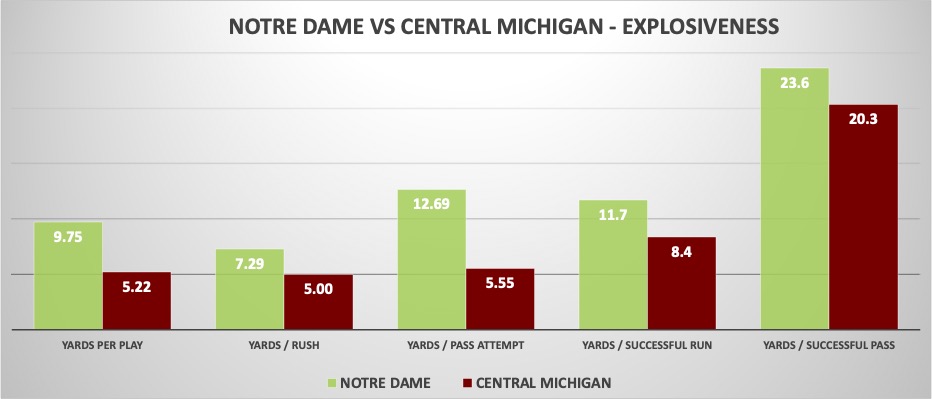
No one plays 12 perfect games in the regular season (not that Notre Dame’s first three were 100% blemish-free). Especially the week before a season-defining showdown, it’s not surprising the Irish looked a little sloppy – especially with some key absences and heavy rotations on defense. Texas looked lukewarm in their opening game at Rice a week before stealing a win in Tuscaloosa.
The final numbers from the Central Michigan win also aren’t problematic. You’d love to hold a bad Chippewa offense under five yards per play, especially on the ground, but +4.5 YPP for the game and winning the efficiency battle by 20% is easy blowout territory. It was really the uncharacteristic disorganization that stood out – penalties, missed assignments or execution on defense, and a few lackluster offensive drives.
Defensively, the Irish gave up a few more explosive plays than ideal, including passes of 31 and 37 yards. But Notre Dame is one of 12 FBS teams yet to give up a play over 40 yards this season, and almost all those teams have only played three games.
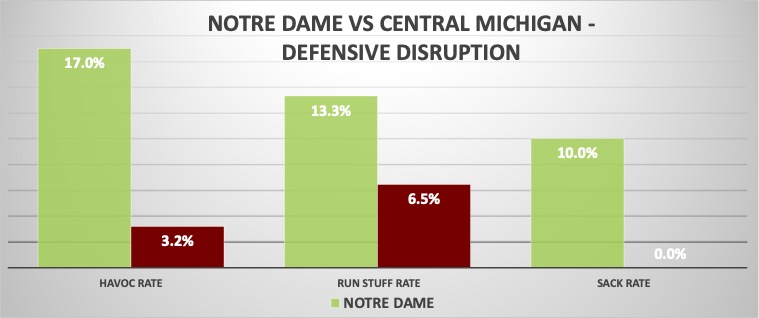
If there’s a slight worry – not specific to the Central Michigan game – it’s a lack of disruption in the run game. The Irish stuff rate (% of runs stopped for no gain or a loss) stands at 14% after 100 carries in competitive situations. It’s a drop-off from last season (17.2%) that’s troubling given the easy schedule to start the year, and a far cry from the strong run defenses of 2018-2020 (which had stuff rates ranging from 18-26%).
It matters, because if Notre Dame can get defenses off-schedule sooner in drives and more routinely as a whole, they’ve been stellar on passing downs. Opponents have had success on just 12 of 62 passing downs (19.4%!) with an average of 4.52 YPP. Opponents are 7/12 converting 3rd and 4 yards to gain or less, and just 6/31 on 3rd and 5 or more.
Everyone digs the long ball
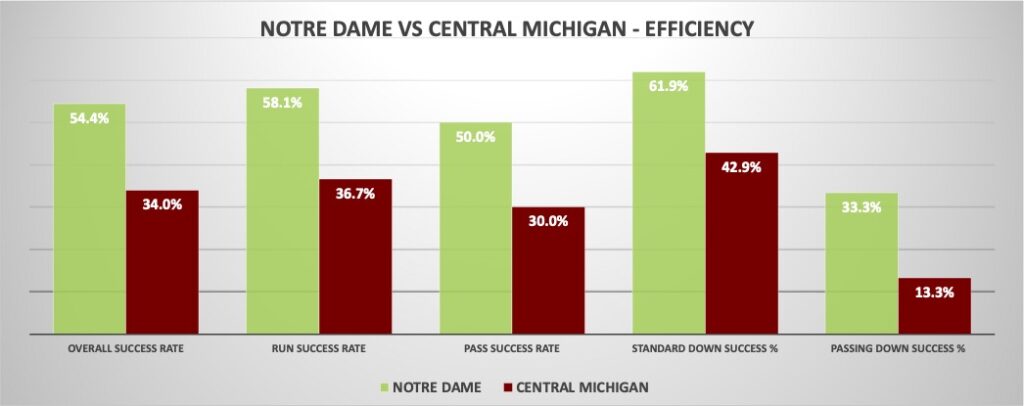
Offensively, the Irish offense continued the combination of very good efficiency and incredible explosiveness that fueled last week’s win in Raleigh. All the strength of schedule caveats apply of course, but all we’ve seen from the Gerad Parker and the Notre Dame offense is this combination or insane efficiency and respectable explosion. Both formulas put points on the board!
The early parts of the first half almost felt like fan service, with long Hartman bombs to Tobias Merriweather and Chris Tyree for scores. The last box for this offense to check off was the home run deep ball, and 16 minutes into the game it was crossed off in style. After that point, the offense struggled with consistency, but was still buoyed by the efficient run game and a few more medium-long gains through the air (including a nice go-route to Rico Flores).
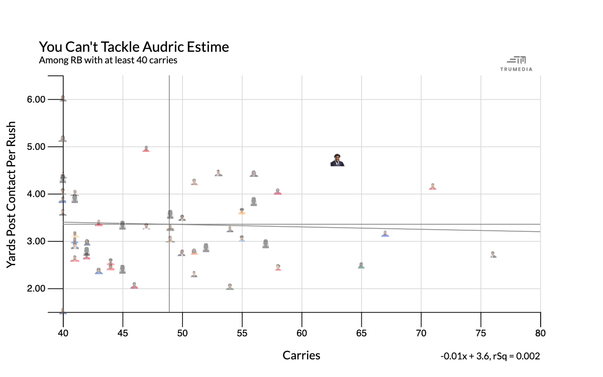
While on the topic of the run game, it must be noted that Audric Estime is doing wild things (graph courtesy of Tom Fornelli’s weekly recap here). A third of the way through the season, he’s feasting on weaker opponents with improvement in every statistical category over his impressive 2022. Estime was one of the most efficient backs in the P5 with a 54% success rate – right now he’s at 64%. His explosive run rate isn’t up quite as much (15% vs 16%) but the length of the long runs has fueled an increase from 5.9 to 8.5 yards per carry. It’s a QB award, but Estime is tied for the best Heisman odds at the moment of any RB (50-1, tied with Blake Corum). And there’s a chance those odds could skyrocket with an impressive performance against the Buckeyes.
“The other stuff” will start mattering more now
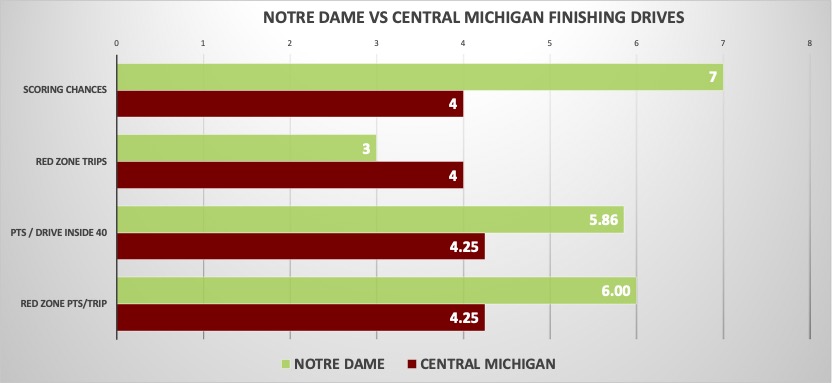
Marcus Freeman’s team has been so good and the schedule so soft that Notre Dame really hasn’t had to worry about what happens at the margins of the game. When you’re dominating both explosiveness and efficiency, the smaller impacts of field position, finishing drives, and turnover luck can matter less.
But as the Irish dive headfirst into the dangerous deep end of the schedule, those factors will come into the spotlight much more. A few odds and ends from the lesser of Bill Connelly’s “Five Factors” – converting scoring chances, field position, and turnovers:
- By the numbers, Notre Dame has been very unfortunate with turnover luck with 5 takeaways vs an expected 8.9 (based on % of fumbles expected to be recovered and pass break ups to be intercepted). It’s almost entirely driven by fumbles – opponents have put the ball on the ground 9 times with 0 ND recoveries.

- StatsBomb had a great special teams article this offseason which highlighted that the most critical aspects of punt return in FBS are simply 1) don’t drop them and 2) don’t let punts bounce. Chris Tyree is at 100% for the first objective, but not doing so well with number two. It has the potential to cost Notre Dame valuable field position over the course of the season, and the last two weeks the Irish have lost the average starting field position battle by a decent margin (-6 yards per drive against CMU, which nets out to 60 yards over the course of a game – significant!)
- The Irish have been very good converting in the red zone and limiting opponents – tied for 9th defensive allowing a TD on just 33.3% of opponent red zone visits, and 10th in offensive TD % (86.7%). An uncanny number of drives have actually stalled out further away in no man’s land, around the opponent 30-40 yard line, leading to 4/6 Spencer Shrader attempts this year coming from 50+.
- The attempt from 59 this week led to a statistical occurrence I haven’t seen before in a Notre Dame game – definitely outside of an end-of-half situation. The Irish attempted the field goal without ever crossing the opponent 40 yard line – so while it was a drive netting zero points, it never technically counted as a scoring opportunity for the graph above and stats like Eckel rate.
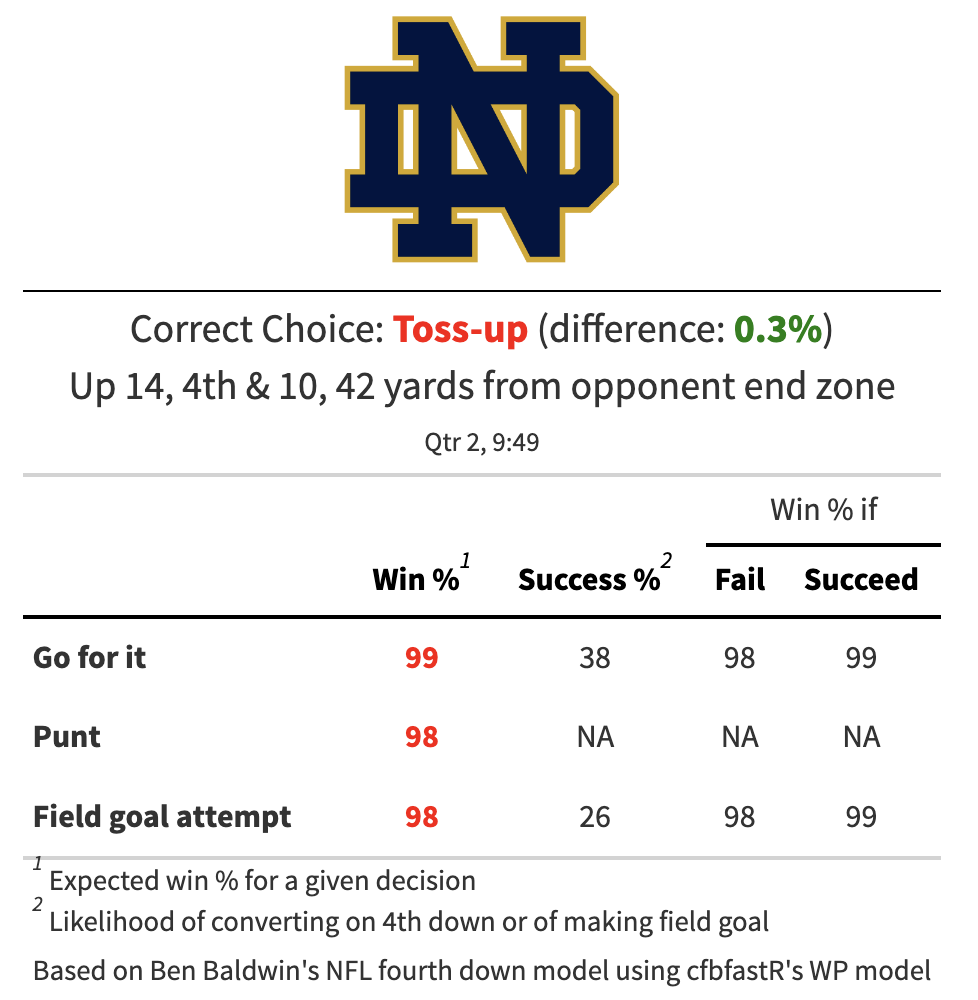
- Drama-free weekends have also led to virtually zero high-stakes decisions for Marcus Freeman and Gerad Parker. The 59-yard attempt was questionable – the “4th down bot” gave the Irish a 38% chance of converting on 4th and 10 versus a 26% chance of a long-distance make. It will be fascinating to see how the ND braintrust plays a dicier situation – let’s say 4th and goal from the 2 in the early going against the Buckeyes.
On to Ohio State
What translates? That’s always the biggest challenge evaluating early-season matchups, and is definitely the case with two teams that have handled their business with massive talent advantages in the early going. The Irish and Buckeyes each played one P5 opponent and faced some minor adversity in that matchup (OSU notably not moving the ball crisply against the IU defense, which is likely not as stout as NC State if we want to get into the transitive property). The Wolfpack defense is the most talented test either team has faced, but Jim Knowles group is in a different category and has passed early season tests with flying colors. Ohio State hasn’t faced an offense like Notre Dame’s, but held a respectable Western Kentucky passing offense in check.
It’s a unique matchup in that I can imagine almost any of the four units taking the field on Saturday staking claim as the best in the game. Ohio State’s defense appears to be the most complete – but are they over the big-play woes that Michigan torched them with and to a slightly lesser degree Georgia in the CFP? Is Kyle McCord going to emerge from this game as the next in a long line of All-American caliber Ohio State QBs throwing to the best wide receivers in the land? Or will he, along with the OL, show shakiness under pressure in a first real road test? Can the Irish offense out-muscle Ohio State? Or will Hartman give an electric performance that proves to be the difference? This will be the longest week in the world waiting for these answers (and is why on a loaded weekend, College Gameday is returning to South Bend).
The most important statistics I’ll be keeping an eye on:
- Rushing success rate: Last year it was the Buckeye rushing attack – not CJ Stroud, Jaxon Smith-Njigba, and Marvin Harrison Jr. – that ultimately enabled OSU to pull away. The Notre Dame front needs to prove they can stop the run, because whew do you not want to leave the secondary on an island against these receivers all night. After a shaky 2022 the run defense has looked better this year, but this is a big step up in talent both in the opposing OL and caliber of athlete Al Golden’s unit needs to tackle.
On the other side, how much can the Irish physically impose their will? Despite Hartman’s near-perfect stats so far, you can imagine Knowles main plan is to dial up the pressure and aggression and to dare the young Irish receivers to make them pay through the air. If Estime and the running game is efficient anyway, that’s a fantastic sign for the offensive success and takes the burden off Hartman and how often he’s exposed to the Buckeye pass rush in obvious passing downs.
- Passing Explosiveness: They won’t all be 70+ yarders, but the Irish will badly need chunk plays – this isn’t an Ohio State defense you can sustain 12 play drives on without near-perfection. Hartman has kept the ball away from danger – incredibly just one pass broken up in four games – but may need to take more (smart) chances to kickstart scoring chances.
In last year’s showdown, the Irish played some terrific “bend but don’t break”, avoiding a back-breaking long touchdown in a hostile environment. It worked until eventually the OSU offense leaned on the run game and hit the right calls on a few mistimed ND blitzes. Notre Dame may take more chances this year depending on their ability to get pressure on McCord, but they’d be wise to similarly avoid the big play and take some turns playing “red zone roulette” if needed.
- Leverage Rate: This is fancy statistic (% of passing downs vs standard downs) for a simple idea – how many plays are you behind schedule for? Both offenses will want to avoid long passing downs, albeit for different reasons. The Irish offense is at it’s best when balanced, and without game-breaking receivers there’s a lot of pressure on Hartman and the young ND receivers. Similarly, Ohio State will want to keep McCord out of trouble and situations where the Irish defense has been excellent so far this year mixing up coverages, disguising blitzes, and getting some of their most talented personnel on the field together.

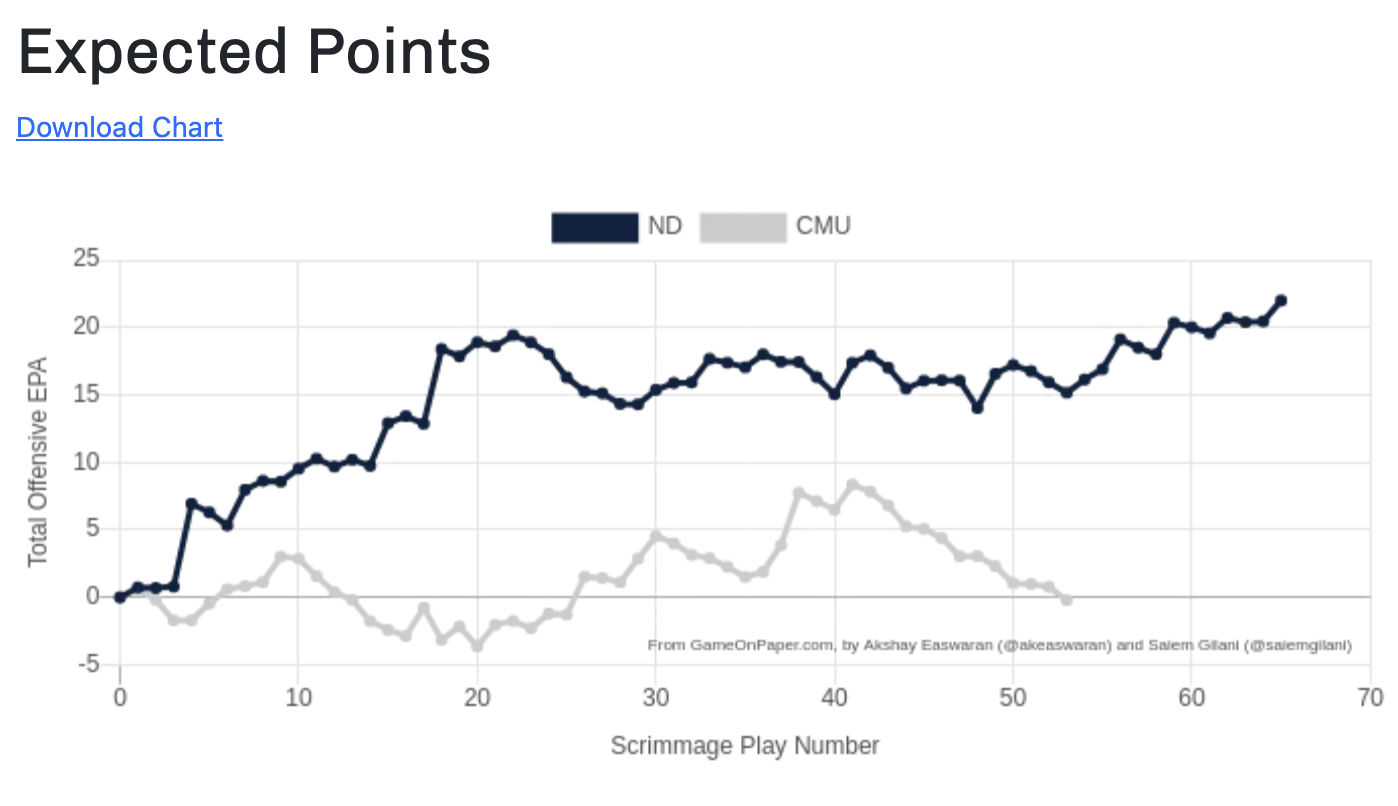



I dont know a lot about our coordinators, but I really hope they have been keeping most of their playbooks in their back pocket up until now.
no doubt, and beat writers have confirmed as much – especially on defense, that there were some pressures and defensive packages this fall they haven’t seen yet
Man, a lot of good news to fill a tense week of waiting.